

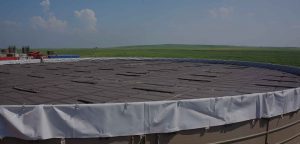
 The NAWC Septage Treatment Facility located in Warminster, PA was founded by NAWC Environmental, LLC and is now owned operated by Wind River Environmental based out of Marlborough, Mass. Wind River Environmental and NAWC Environmental specialize in transporting and treating a broad array of non-hazardous liquid waste systems, including grease traps, septic tanks, and related waste systems.
The NAWC Septage Treatment Facility located in Warminster, PA was founded by NAWC Environmental, LLC and is now owned operated by Wind River Environmental based out of Marlborough, Mass. Wind River Environmental and NAWC Environmental specialize in transporting and treating a broad array of non-hazardous liquid waste systems, including grease traps, septic tanks, and related waste systems.
THE PROBLEM: The facility has multiple open top tanks which allowed odors to be released to atmosphere, resulting in complaints from neighbors.
THE SOLUTION: Covering the tank enabled NAWC Environmental to capture the odors emitted from the tank, where they could then evacuate the headspace using a blower and send it through a biofilter before being released to the atmosphere.
THE RESULT: IEC’s Flexible Tank Cover has successfully contained the odors in the EQ tank, and neither ownership (NAWC Environmental, nor Wind River Environmental) has had any complaints in nearly four years!
CONCLUSION: IEC’s Flexible Tank Cover has performed as intended to capture odors from the EQ tank at the NAWC Septage Treatment Facility in Warminster, Pennsylvania. Since cover installation, there have IEC Case Study – Warminster, PA – IEC Flexible Tank Coverbeen no complaints from the community.
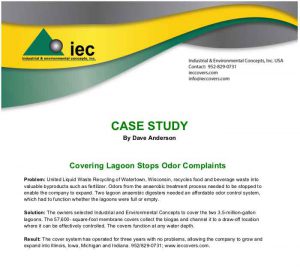
A CASE STUDY
Covering lagoon stops odor complaints.
Problem: United Liquid Waste Recycling of Watertown, Wisconsin, recycles food and beverage waste into valuable byproducts such as fertilizer. Odors from the anaerobic treatment process needed to be stopped to enable the company to expand. Two lagoon anaerobic digesters needed an affordable odor control system, which had to function whether the lagoons were full or empty.
Solution: The owners selected Industrial and Environmental Concepts to cover the two 3.5-million-gallon lagoons. The 57,600- square-foot membrane covers collect the biogas and channel it to a draw-off location where it can be effectively controlled. The covers function at any water depth.
Result: The cover system has operated for three years with no problems, allowing the company to grow and expand into Illinois, Iowa, Michigan and Indiana. 952/829-0731; www.ieccovers.com.
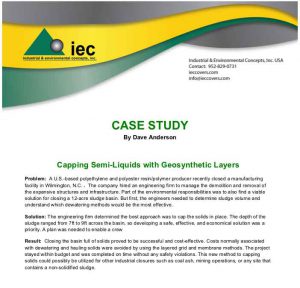
A CASE STUDY
Capping semi-liquid solids with geosynthetic layers
Problem:
A U.S.-based polyethylene and polyester resin/polymer producer recently closed a manufacturing facility in Wilmington, N.C. . The company hired an engineering firm to manage the demolition and removal of the expansive
structures and infrastructure. Part of the environmental responsibilities was to also find a viable solution for closing a 12-acre sludge basin. But first, the engineers needed to determine sludge volume and understand which dewatering methods would be the most effective.
Solution: The engineering firm determined the best approach was to cap the solids in place. The depth of the sludge ranged from 7ft to 9ft across the basin, so developing a safe, effective, and economical solution was a priority. A plan was needed to enable a crew
Result: Closing the basin full of solids proved to be successful and cost-effective. Costs normally associated with dewatering and hauling solids were avoided by using the layered grid and membrane methods. The project stayed within budget and was completed on time without any safety violations. This new method to capping solids could possibly be utilized for other industrial closures such as coal ash, mining operations, or any site that contains a non-solidified sludge.
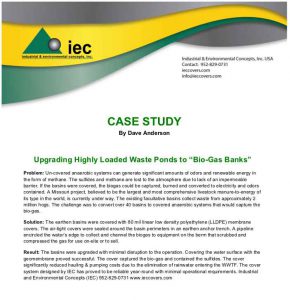
A CASE STUDY
By Dave Anderson
Upgrading Highly Loaded Waste Ponds to “Bio-Gas Banks”
Problem: Un-covered anaerobic systems can generate significant amounts of odors and renewable energy in the form of methane. The sulfides and methane are lost to the atmosphere due to lack of an impermeable barrier. If the basins were covered, the biogas could be captured, burned and converted to electricity and odors contained. A Missouri project, believed to be the largest and most comprehensive livestock manure-to-energy of its type in the world, is currently under way. The existing facultative basins collect waste from approximately 2 million hogs. The challenge was to convert over 40 basins to covered anaerobic systems that would capture the bio-gas.
Solution: The earthen basins were covered with 80 mil linear low density polyethylene (LLDPE) membrane covers. The air-tight covers were sealed around the basin perimeters in an earthen anchor trench. A pipeline encircled the water’s edge to collect and channel the biogas to equipment on the berm that scrubbed and compressed the gas for use on-site or to sell.
Result: The basins were upgraded with minimal disruption to the operation. Covering the water surface with the geomembrane proved successful. The cover captured the bio-gas and contained the sulfides. The cover significantly reduced hauling & pumping costs due to the elimination of rainwater entering the WWTF. The cover system designed by IEC has proved to be reliable year-round with minimal operational requirements. Industrial and Environmental Concepts (IEC) 952-829-0731 www.ieccovers.com
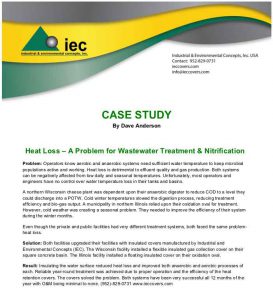
A CASE STUDY
By Dave Anderson
Heat Loss – A Problem for Wastewater Treatment & Nitrification
Problem: Operators know aerobic and anaerobic systems need sufficient water temperature to keep microbial populations active and working. Heat loss is detrimental to effluent quality and gas production. Both systems can be negatively affected from low daily and seasonal temperatures. Unfortunately, most operators and engineers have no control over water temperature loss in their tanks and basins.
A northern Wisconsin cheese plant was dependent upon their anaerobic digester to reduce COD to a level they could discharge into a POTW. Cold winter temperatures slowed the digestion process, reducing treatment efficiency and bio-gas output. A municipality in northern Illinois relied upon their oxidation oval for treatment. However, cold weather was creating a seasonal problem. They needed to improve the efficiency of their system during the winter months.
Even though the private and public facilities had very different treatment systems, both faced the same problem-heat loss.
Solution: Both facilities upgraded their facilities with insulated covers manufactured by Industrial and Environmental Concepts (IEC). The Wisconsin facility installed a flexible insulated gas collection cover on their square concrete basin. The Illinois facility installed a floating insulated cover on their oxidation oval.
Result: Insulating the water surface reduced heat loss and improved both anaerobic and aerobic processes of each. Reliable year-round treatment was achieved due to proper operation and the efficiency of the heat retention covers. The covers solved the problem. Both systems have been very successful all 12 months of the year with O&M being minimal to none. (952)-829-0731 www.ieccovers.com
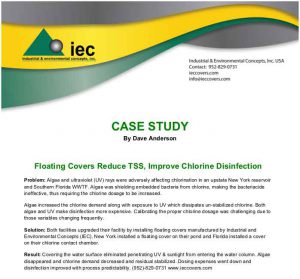
CASE STUDY
By Dave Anderson
Floating Covers Reduce TSS, Improve Chlorine Disinfection
Problem: Algae and ultraviolet (UV) rays were adversely affecting chlorination in an upstate New York reservoir and Southern Florida WWTF. Algae was shielding embedded bacteria from chlorine, making the bacteriacide ineffective, thus requiring the chlorine dosage to be increased.
Algae increased the chlorine demand along with exposure to UV which dissipates un-stabilized chlorine. Both algae and UV make disinfection more expensive. Calibrating the proper chlorine dosage was challenging due to those variables changing frequently.
Solution: Both facilities upgraded their facility by installing floating covers manufactured by Industrial and Environmental Concepts (IEC). New York installed a floating cover on their pond and Florida installed a cover on their chlorine contact chamber.
Result: Covering the water surface eliminated penetrating UV & sunlight from entering the water column. Algae disappeared and chlorine demand decreased and residual stabilized. Dosing expenses went down and disinfection improved with process predictability. (952)-829-0731 www.ieccovers.com
Our innovative modular covers provide a solution for issues like odor control, heat retention, gas collection and storage, evaporation mitigation, algae control, animal control, and more. Whether you need a cover for industrial, municipal or agricultural purposes, IEC can help!